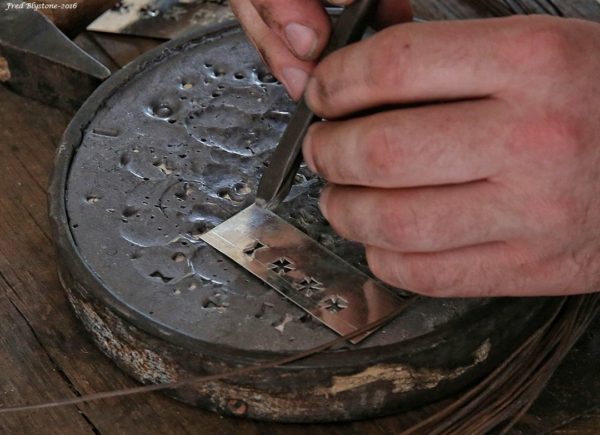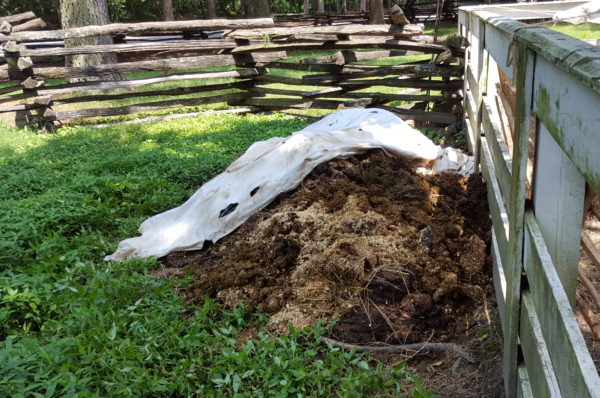
This summer we’ve been playing scientists here at Coach & Livestock. As you may remember from a previous blog post, we’ve been trying to recreate an 18th-century method of hatching chicken eggs. Since things are slowing down a bit after our peak summer season, we thought it was time for a progress report.
We’ve been trying out a method published by French scientist René-Antoine Ferchault de Réaumur in 1750. He developed an inexpensive system using an old barrel and pile of dung so that “the inhabitants of all places should have easy methods of hatching chickens and other domestick fowls in what quantity the pleased.” So how did this easy method work out for us?
Unfortunately, it was not quite as simple as we’d hoped. Believe it or not, even in the middle of a heat wave we couldn’t keep the temperature in the barrel high enough!
Everything started out alright, but things quickly went awry. We made a big pile of manure using pure horse dung with a little straw mixed in, just like Réaumur suggested. Like any good Enlightenment scientist, we kept a record of the pile’s temperature. Once the manure started cooking, we decided to fire up the incubator when it reached 138˚F.
Earlier in the year we built a frame around the barrel so our guests’ shoes might stay a bit cleaner. While I am constantly stepping in smelly things, most people prefer not to perfume their shoes with eau de horse manure. We spent one hot July afternoon pitching dung into the frame and the incubator was ready to go! Or so we thought…
We were initially able to hit a constant 95˚F inside the barrel, but we were still short of the 101˚F we needed to set our eggs. We kept checking the nice new thermometer that the Tin Shop made for us, but every time it read a little bit lower. Why wasn’t our incubator working?

We thought we might not have added enough straw, so we mixed a bit more into the dung. We also followed Réaumur’s advice of turning the manure and wetting it down. All of these adjustments did in fact increase the temperature, but not enough.

Our current theory is that we didn’t use enough manure. Our handy little shoe saving frame may have been our undoing. We built the frame using scrap material and it turned out to be a little short of the two feet in every direction that Réaumur recommended. We thought it wouldn’t make that much of a difference since we were only a little short, but as it turns out we didn’t have enough volume to maintain the heat. Lesson learned: always listen to de Réaumur.
Fortunately we had a backup plan. We also set a Dominique hen in a nest box at the Powell house. While she may have struggled a bit to maintain proper temperature and humidity too (it was really hot and humid this summer), she still managed to hatch out two chicks. They now reside at our modern stables and will join the rest of the flock once they are a bit bigger.
We plan to continue our experiments and hopefully one day we’ll be able to hatch out chicks just as well as a mother hen!
GUEST BLOGGER: Layne Anderson
Layne Anderson is a Livestock Husbander/Interpreter in the Coach and Livestock Department. She has a long history with the Colonial Capital. Not only did she study Biology at the College of William & Mary, but her maternal grandparents, parents, and sister all attended as well. She spent her youth coming to Colonial Williamsburg for field trips and family vacations. After graduating, Layne left Virginia to work in the field of wildlife conservation, but returned to Williamsburg in 2013 after her husband landed a job in the Tin Shop. She joined the Foundation herself in 2014 and loves her position because she can pursue her interests in animal husbandry, Rare Breeds conservation, and history.
Thanks, I loved reading this post and going back in time with you.
Enjoyed following this and shared it with my sister in Arizona who is setting out as a bit of a novice to try to raise good quality Lavender Orpingtons. She is having a little trouble finding quality books or other resources, particularly concerning the genetics and actual breeding. Do you have any you recommendations, or does the rare breeds program have books for sale on this through the foundation? Looking forward to a trip out there from San Diego area in 3 weeks. We will look for you (as well as our friends Liz and Jerry!)
Thank you for the update on the hatching out project. Sorry that it didn’t work. Did you “candle” any of the eggs along the way? Hoping to be visiting either around Halloween or November 9-11. Will you be around the barns for Q & A’s? My days of incubating via the electric model or broody hen are long past now as I travel too often to keep them, but still find it a fascinating subject.
I would think straw would lower the temperature. My wife and I had five horses for the first 30 years of our marriage, but as they died of old age, one by one, we decided against buying new ones. Anyway, many is the cold morning I saw steam rising from the manure pile that would get carted to the garden in the spring. They do get hot.
But there is nothing like a good broody hen, (ours is named ‘”Buckbeak”, to raise chicks. She hatches 12 or more with no trouble and then does a great job of keeping the pesky other hens and rooster away from them when the chicks and her are wandering around scratching. She shows them the ropes like a barrel of manure can’t. But I was interested in the experiment and thought it a neat thing to try.
It is constantly fascinating to hear the stories of how the CW staff uses historical methods. So interesting! Thank you.
What cute chicks!
I wonder whether Monsieur Reaumur actually conducted (or had his servants) conduct the incubation experiment, or perhaps only set quill pen to paper. It certainly would not have been as hot (and humid!) in France as in a southeastern VA summer. I doubt French manure is any more heat-generating or retentive than that of good ol’ American equines.
Thanks for posting your experiment and results. Thomas Jefferson and Ben Franklin, being of scientific minds, would have approved!
Grat story. Very interesting and I hope, you will keep all of us posted on your progress. Thanks!